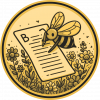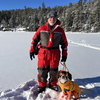In recent decades, the use of dogs in conservation work has exploded. Deployed to detect things like invasive or elusive species, scat, poachers, illegal wildlife trade products, and much more, conservation dog teams are trained to aid teams in the field. With benefits like speedier searches over large areas, proven targeted detection accuracy, and ease of transport and surveying, conservation dogs also offer possibilities for enhancing other technological methods by confirming or providing results in real-time.
Conservation dog teams now provide scat, reptile, aquatic species, whale scat, and invasive plant detection, and plenty more. This expansion of use is partly due to refined training techniques that offer a broader capability in very specialized detection roles, and partly due to more people seeing the capabilities and benefits of trained dogs.
Specifically, the utilization of dogs in conservation has experienced a considerable increase in recent years as people realize what the capability brings to the field survey arena. The benefits of dogs offering enhanced detection to support surveys includes:
- Speed of search
- Covering large areas effectively
- Proven detection capability
- Calibrated on a variety of species, if required
- Accuracy in the detection of targets and ignoring similar non-target specimens
- And easy to transport to survey sites.
Whether you train, handle, use, or are interested in finding out more about conservation dogs, this is the community for you! This group is growing, so if you'd like to get started and make connections here, here are some suggestions:
- Do you have advice to share with others who are interested in trying conservation dog work for the first time? Or do you need advice on whether conservation dogs suit your work?
- Do you have resources or research to share on training or using conservation dogs?
- Do you have a case study or project update that involves conservation dogs?
- Do you have a question about how to access conservation dogs for your own work?
Your group manager is Paul Bunker. Direct message him through WILDLABS or email him here with any questions or suggestions.
Header photo: Bill, photographed by Stephanie O'Donnell
No showcases have been added to this group yet.
- @Ziggy
- | She/Her
Aquatic biologist focused on aquatic invasive species and freshwater pearly mussels
- 0 Resources
- 0 Discussions
- 4 Groups
- @mattaudette
- | he, him, his
Software Tester and Test Automator at Wildlife Protection Solutions
- 0 Resources
- 1 Discussions
- 24 Groups
- @kricherds
- | she/her
Technologist. Civic Science Fellow & Data Inclusion Specialist at OEDP.

- 0 Resources
- 0 Discussions
- 14 Groups
- 0 Resources
- 0 Discussions
- 5 Groups
- @CitlalliMJ6
- | she/her
Conservation biologist, executive director at the Tesoro Escondido Reserve Foundation in the Ecuadorian Chocó, working on participatory action research, environmental education, primate and amphibian conservation
- 0 Resources
- 0 Discussions
- 7 Groups
St. Lawrence University
Professor of Biology at St. Lawrence University
- 0 Resources
- 2 Discussions
- 12 Groups
- 0 Resources
- 0 Discussions
- 16 Groups
World Wide Fund for Nature/ World Wildlife Fund (WWF)
- 0 Resources
- 7 Discussions
- 12 Groups
Botswana Predator Conservation Trust



- 0 Resources
- 85 Discussions
- 10 Groups
Dedicated wildlife conservationist with over three years of hands-on experience in field research and conservation. Through extensive fieldwork i developed a strong foundation in various conservation techniques, including camera trap deployment, plant inventory methods.
- 0 Resources
- 0 Discussions
- 9 Groups
- 0 Resources
- 0 Discussions
- 4 Groups
University of British Columbia
Postdoc at UBC, exploring how drones enhance wildlife conservation using thermal cameras & AI tools to refine monitoring of large mammal populations in Canada & compare these approaches to traditional methods.
- 0 Resources
- 0 Discussions
- 7 Groups
Scientists at Victoria's Healesville Sanctuary are using trained sniffer dogs on paddleboards to track and identify platypuses in their habitat.
23 July 2025
Murray-Darling carpet python populations in South Australia have declined due to loss of habitat and predation. Trials using conservation detection dogs to find the snakes in the Riverland have so far had positive...
26 May 2025
A published research study
15 January 2025
Their keen noses are helping researchers document the diversity of fungi living underneath Pacific Northwest forests.
15 January 2025
Published research paper
27 August 2024
WildLabs will soon launch a 'Funding and Finance' group. What would be your wish list for such a group? Would you be interested in co-managing or otherwise helping out?
5 June 2024
YouTube link to interview regarding the Saola Detection Canine project in Laos
10 December 2023
This article discusses a project utilizing canines to detect the scat of a critically endangered mammal, the Saola.
10 December 2023
A secure platform designed for those working to monitor & protect natural resources. Insight facilitates sharing experience, knowledge & tools to increase efficiency & effectiveness in conservation. By...
7 November 2023
Detection dogs may provide a non-invasive way to determine female receptivity, but this has not been explored in captive wildlife. This exploratory study investigated the use of detection dogs as a novel method of...
25 October 2023
By sniffing out egg masses, dogs are helping researchers against an invasive species
26 April 2023
Published paper attached
14 November 2022
December 2023
event
| Description | Activity | Replies | Groups | Updated |
|---|---|---|---|---|
| "To find the elusive white-vented storm petrel, researchers spent years scouring the desolate Atacama Desert, using dogs to help sniff... |
|
Conservation Dogs | 4 years 4 months ago | |
| "This paper describes the training methodology used to investigate the ability of a scent detection dog to locate live riverine... |
|
Conservation Dogs | 4 years 4 months ago | |
| This is great! I would love to learn more about how search area and transects affect detection. I look forward to reading her articles. |
|
Conservation Dogs | 4 years 4 months ago | |
| This is awesome!! Thanks for sharing. Reading about doggo's for "work" (and fun) is so lovely |
|
Conservation Dogs | 4 years 4 months ago | |
| "When presented with the challenge of detecting P. adspersus scent amid other amphibian scents (species identification test),... |
|
Conservation Dogs | 4 years 5 months ago | |
| A news article regarding the invasive North American red-eared slider turtle in Australia and the use of dogs to support conservation... |
|
Conservation Dogs | 4 years 5 months ago | |
| Benefits of incorporating a scat-detection dog into wildlife monitoring: a case study of Pyrenean brown bear. Conservation detector dogs... |
|
Conservation Dogs | 4 years 5 months ago | |
| "This issue features 14 papers from seven countries in Africa and Europe and one review paper with global coverage, focusing on dog... |
|
Conservation Dogs | 4 years 5 months ago | |
| If and when you're ready to get a ton of attention (and maybe fundraise) for your conservation dog work send those pix to @dog_rates as I'm sure Matt would love to feature... |
+11
|
Conservation Dogs | 4 years 5 months ago | |
| Check out this very helpful paper on how detector dogs were trained to conduct surveys to find the threatened Eastern Indigo Snake.... |
|
Conservation Dogs | 4 years 6 months ago | |
| This is a recording of an interview with Rogue Detection Dogs about their work: "In this webcast, we learn all about how this work... |
|
Conservation Dogs | 4 years 6 months ago | |
| I have seen posts on social media about poison detection dogs and I THINK I am connected to one of the teams. I will check. Paul |
|
Conservation Dogs | 4 years 6 months ago |






















